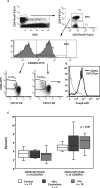Infection of CD127+ (interleukin-7 receptor+) CD4+ cells and overexpression of CTLA-4 are linked to loss of antigen-specific CD4 T cells during primary human immunodeficiency virus type 1 infection
- PMID: 17005693
- PMCID: PMC1617311
- DOI: 10.1128/JVI.00249-06
Infection of CD127+ (interleukin-7 receptor+) CD4+ cells and overexpression of CTLA-4 are linked to loss of antigen-specific CD4 T cells during primary human immunodeficiency virus type 1 infection
Abstract
We recently found that human immunodeficiency virus (HIV)-specific CD4+ T cells express coreceptor CCR5 and activation antigen CD38 during early primary HIV-1 infection (PHI) but then rapidly disappear from the circulation. This cell loss may be due to susceptibility to infection with HIV-1 but could also be due to inappropriate apoptosis, an expansion of T regulatory cells, trafficking out of the circulation, or dysfunction. We purified CD38+++CD4+ T cells from peripheral blood mononuclear cells, measured their level of HIV-1 DNA by PCR, and found that about 10% of this population was infected. However, a small subset of HIV-specific CD4+) T cells also expressed CD127, a marker of long-term memory cells. Purified CD127+CD4+ lymphocytes contained fivefold more copies of HIV-1 DNA per cell than did CD127-negative CD4+ cells, suggesting preferential infection of long-term memory cells. We observed no apoptosis of antigen-specific CD4+ T cells in vitro and only a small increase in CD45RO+CD25+CD127dimCD4+ T regulatory cells during PHI. However, 40% of CCR5+CD38+++ CD4+ T cells expressed gut-homing integrins, suggesting trafficking through gut-associated lymphoid tissue (GALT). Furthermore, 80% of HIV-specific CD4+ T cells expressed high levels of the negative regulator CTLA-4 in response to antigen stimulation in vitro, which was probably contributing to their inability to produce interleukin-2 and proliferate. Taken together, the loss of HIV-specific CD4+ T cells is associated with a combination of an infection of CCR5+ CD127+ memory CD4+ T cells, possibly in GALT, and a high expression of the inhibitory receptor CTLA-4.
Figures





References
-
- Acuto, O., and F. Michel. 2003. CD28-mediated co-stimulation: a quantitative support for TCR signalling. Nat. Rev. Immunol. 3:939-951. - PubMed
-
- Andersson, J., A. Boasso, J. Nilsson, R. Zhang, N. J. Shire, S. Lindback, G. M. Shearer, and C. A. Chougnet. 2005. The prevalence of regulatory T cells in lymphoid tissue is correlated with viral load in HIV-infected patients. J. Immunol. 174:3143-3147. - PubMed
-
- Bachmann, M. F., A. Gallimore, E. Jones, B. Ecabert, H. Acha-Orbea, and M. Kopf. 2001. Normal pathogen-specific immune responses mounted by CTLA-4-deficient T cells: a paradigm reconsidered. Eur. J. Immunol. 31:450-458. - PubMed
Publication types
MeSH terms
Substances
LinkOut - more resources
Full Text Sources
Medical
Research Materials

